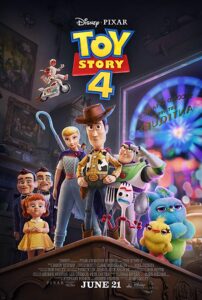The best comedy of the summer is a Pixar sequel.


Not quite a parody of the historic “Toy Story” franchise, “Toy Story 4” is funnier than it is impactful. For some, the tears will flow without reservation, but I questioned how much of that engaging sentimentality is just the byproduct of Pixar goodwill. Anything from the blockbuster animation house is bound to evoke a range of emotions, and in sequels, there have been diminishing emotional returns. It’s hard to duplicate the gripping narrative power that worked its way into our collective psyche with original stories like “Up” and “Inside Out.” Yet another helping of “Toy Story” is, at some point, just not going to resonate.

Taking place after the events of 2010’s “Toy Story 3,” Bonnie (voice of Madeleine McGraw) has taken over ownership of the toys. With the emergence of a new highly organized rag doll leader, Woody’s (Tom Hanks) authority over his tight-nit group has shrunk. To make matters even more dire, he’s not a priority to Bonnie. But when she goes off to kindergarten, Woody sees an opportunity to help his little girl adjust. After all, we all need a friend to help us get by, right?

In kindergarten, Bonnie, with Woody’s clandestine assistance, makes a toy using a combination of art supplies and trash. This new toy she understandably names Forky (voiced by the great Tony Hale), and it’s up to Woody to protect and educate this new friend. In time, Bonnie and her parents go on vacation renting an RV and taking the toys along for the ride. Once on the road, the toys have a rollicking adventure, and Woody learns about himself, while helping Bonnie in the process.
A typical Pixar production, “Toy Story 4” is top-notch from top to bottom. Voice talents are an absolute delight with new comers Hale, Christina Hendricks, Carl Weathers, Keanu Reeves and others adding to the fun. But “fun” is the operative word here. The central morals are obviously told but with less punch than the previous installments. Perhaps taking lessons from the third film, the threatening material is handled with less menace, managing to resolve things without going too dark. Parents need not worry, there’s no Lotso in this “Toy Story.”

But, I suppose, while most audiences will find number four to be immensely entertaining, the question some will be asking is why is this movie even necessary? The somewhat maligned third movie brought to a close to the trilogy, complete with a moving conclusion. This movie might frustrate “Toy Story” purists, because it does leave open the possibility of continuing adventures, although maybe focusing on individual toy stories. And admittedly, absent all the toys being annihilated (as almost happened in the last outing), I suppose ending a franchise this lucrative is impossible.

Money first, story second. Even less cynical critics than I will have to recognize the profit motive here. It’s hard to deny that Pixar turned back to the hit film and characters that gave rise to the studio in order to ensure continuing financial returns. One way to justify this mercenary business strategy is the hope that the profit from this sequel might help finance other original projects. And the major accomplishment shown here is that the team at Pixar are so talented that they figured out a way to make another “Toy Story” work. That’s quite an achievement.
While not as dark or sweeping as previous entries, the often hilarious “Toy Story 4” will tickle your funny bone with slightly less emotional import.
